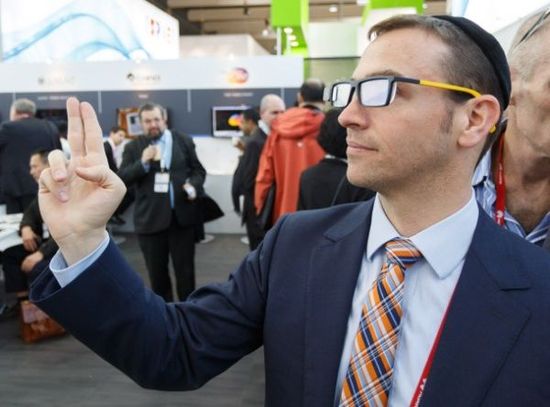Category: Wearables
-

Facial expression controlled ear computer/health monitor
AFP | Japan Times Kazuhiro Taniguchi of Hiroshima City University has developed a 17 gram “Earclip-type Wearable PC” equipped with a GPS, compass, gyrosensor, battery, barometer, speaker and microphone. A microchip and data storage enable users to load software. The device is being tested now, with promising applications for the elderly and disabled. The system…
-

Lumus/EyeSight partnership to rival Google Glass
In an effort to compete with Google Glass, gesture control company EyeSight Mobile has partnered with smart glass company Lumus. The combination allows one to browse Facebook, play games, or control navigation instructions shown in a head-up display by holding out a finger to tap on icons or swipe away notifications. EyeSight plans to add the ability…
-
Smart contact lens with potential to monitor intraocular pressure
http://www.nature.com/ncomms/2014/140107/ncomms3982/full/ncomms3982.html Swiss Federal Institute of Technology scientists have developed a light, flexible, ultra-thin membrane with the potential to detect intraocular pressure in glaucoma. Researchers claim that the technology “could offer significant advantages over existing solutions in terms of thickness, lightness, and transparency and, hence, comfort for the patient.” The device consists of layered polymer films, one…
-
Smart glasses see veins beneath skin
http://evenamed.com/products/glasses Eyes-On smart glasses allow healthcare providers to see the vasculature beneath a patients skin, simplifying intravenous placement. Veins are seen by the the device’s capture of multi-spectral lighting through two stereoscopic cameras which highlight deoxygenated hemoglobin. The cameras can transmit the images wirelessly, store photo and video documentation of a procedure, and connect to a hospital…
-
Tongue based magnetic field controls wheelchair
http://stm.sciencemag.org/content/5/213/213ra166 Maysam Ghovanloo of Georgia Tech and Anne Laumann of Northwestern have developed a tongue piercing based magnet to operate a wheelchair. The device is a small magnetic barbell which creates a magnetic field in the mouth. When users flick their tongues, it alters that field. The change is picked up by four small sensors…
-
Sony’s “SmartWig” can monitor and transmit health data
US Patent Office Sony has submitted a patent application for a health monitoring “SmartWig.” It can include a GPS and camera placed near the forehead. Users can receive vibrating feedback on specific parts of their head. A laser pointer and remote can be controlled by the head’s movement. An ultrasound transducer could transmit or receive…
-
NIH funds robots for the vision impaired, stroke patients, doctors performing catheter ablation
http://www.nih.gov/news/health/oct2013/nibib-23.htm Three projects have been awarded funding by the National Institutes of Health. All involve robots that cooperate with people and adapt to changing environments to improve human capabilities and enhance medical procedures. A co-robotic navigation device for the blind: Cang Ye at University of Arkansas is incorporating 3D imaging sensor technology into the white cane. This…
-
Printable, multi-touch sensors consumers can cut with scissors
http://embodied.mpi-inf.mpg.de/files/2012/11/ACuttableMultiTouchSensor.pdf Max Planck Institute researchers and the MIT Media Lab have developed printable, multi-touch sensors that are printed with e-ink and can be cut with scissors. A new circuit layout makes it robust against cuts, damage, and removed areas. By customizing and pasting such a sensor, one can make every surface interactive, including the wristband…
-
Transparent artificial muscle plays music, demonstrating capabilities of ionic conductors
http://www.sciencemag.org/content/341/6149/984.full Harvard researchers have demonstrated that electrical charges carried by ions, rather than electrons, can be put to meaningful use in fast-moving, high-voltage devices. These ionic conductors can be stretched to many times their normal area without an increase in resistivity—a problem common in stretchable electronic devices. They can be transparent, making them well suited…
-
Data glasses controlled by eye movement — an alternative to brain machine interface
http://www.domain-b.com/technology/20130912_movements.html Researchers at the Fraunhofer Institute have developed bidirectional OLED microdisplay eye-controlled data glasses. Users can view the real world while browsing a large amount of virtual information and turn pages with their eyes. Integrated camera sensors register the direction of the wearer’s eye movements and an image processing program calculates the exact position of…
-
ECG wristband sensors use your heartbeat as your password
http://www.getnymi.com The Nymi wristband confirms a user’s identity via electrocardiogram sensors that monitor the heartbeat and can authenticate a range of devices, from iPads to cars. Developers at Bionym, the Toronto-based company that makes the device, say the peeks and valleys of an individual’s heartbeat are harder to imitate than the external features of biometric…
-
Mayo Clinic studies step tracking data as a post-surgery monitoring tool
http://www.annalsthoracicsurgery.org/article/S0003-4975(13)01253-8/fulltext Mayo Clinic has published a study using step recording from a Fitbit activity tracker to monitor recovery in cardiac surgery patients and help hospitals determine the appropriate length of stay. Those who had the shortest hospital stay walked the most on all days in the study, by a statistically significant margin. Likewise, patients bound for home walked…